Fun Painting Ideas for Beginner Artists and Kids


Intro
Painting has long been a channel for expressing thoughts, feelings, and ideas. For beginners, especially elementary school children, it can serve as a gateway to discover the vast world of creativity. The vibrant colors, the smooth strokes of the brush, and the blank canvas all invite exploration. Not only does painting nurture a child’s creative instincts, but it also supports cognitive and emotional growth.
In this article, we will explore a variety of painting techniques, fun themes, and accessible materials, all designed to inspire budding artists.
By breaking down the process, both children and their guardians can find joy in creating art together. Let’s roll up those sleeves and dive into the colorful world of painting!
Creative Activities
Engaging in creative activities promotes not just artistic skills but also fosters a sense of accomplishment and joy. Below are some painting ideas that are perfect for beginners.
Craft Ideas
- Nature Prints: Using leaves or flowers, dip them in paint and press down on paper. This creates unique imprints that resemble natural art.
- Bubble Wrap Art: Paint a piece of bubble wrap, press paper onto it, and peel away for a fun texture.
- Salt Dough Ornaments: Children can make ornaments with salt dough, paint them with colors afterward, bringing their imagination to life.
- Sponge Painting: Cut sponges into shapes, dip in paint, and stamp on paper. This method can produce exciting patterns.
Step-by-Step Guides
Let’s look more closely at how to pursue one of these ideas.
Nature Prints
- Materials Needed: Leaves, paint, paper, paintbrush.
- Instructions:
- Collect interesting leaves or flowers from outside.
- Apply paint to one side of the leaf using the brush.
- Press the painted side onto your paper gently.
- Carefully lift the leaf and admire your print!
- To create details, you can use a brush to add further elements around the prints.
Educational Value
Engaging in painting projects holds significant educational benefits. These activities can:
- Enhance fine motor skills through brush control and handling materials.
- Stimulate creativity by encouraging individual expression.
- Foster patience and focus as children learn to concentrate on the task at hand.
Additional Insights
"Art enables us to find ourselves and lose ourselves at the same time."
Allowing children to explore painting techniques creates a foundation of knowledge that can fuel their future creativity. This balanced approach to artistic expression creates a safe space for children to develop not only their skills but also a passion for art that can last a lifetime.
Prolusion to Painting for Beginners
Stepping into the world of painting can feel like stepping onto a blank canvas, full of potential and possibility. Painting not only allows self-expression but also promotes emotional growth, fine motor skills, and cognitive development. For beginners, especially young children, it emerges as a door to creativity that is both inviting and rewarding. In this section, we will chat about why this artistic journey is crucial for those taking their first strokes.
Understanding the Importance of Creativity
Creativity is like a muscle; the more you use it, the stronger it gets. Encouraging creativity in children through activities like painting fosters a love for exploration and problem-solving. When kids pick up a brush and dive into colors, they begin to understand concepts like mixing and contrast in a genuine and personal manner.
Creating art helps them express emotions that they may not yet have the words for, a journey of self-discovery. Even beyond the colors and canvases, tapping into creativity cultivates resilience, as every mistake can be turned into an opportunity for improvement.
"Creativity takes courage." – Henri Matisse.
This statement rings true as young artists often face their inner critics, but pushing through those doubts leads to growth. Painting nurtures patience and discipline, proving that art is not just about the product but the process.
Why Painting is a Great Starting Point
Picking up painting as a beginner presents an array of benefits. It encompasses a simple and versatile platform for artistic exploration. Unlike more complex forms of art, such as sculpture or digital design, painting requires minimal tools – only some paint, brushes, and a surface.
- Accessibility: Most people can access basic painting supplies without breaking the bank. Whether it’s watercolors, acrylics, or even tempera paints, there’s something for every budget.
- Versatility: Young learners can explore various themes and techniques with painting, allowing for freedom in choosing their styles.
- Expression: Painting offers a unique outlet to articulate thoughts, feelings, and experiences. Kids can literally put their imaginations on display.
- Social Interaction: Engaging in painting activities, whether in a classroom or at home with family, fosters social bonds, encouraging teamwork and collaboration.
With these compelling points, it's clear that painting serves not only as a means for creative expression but also as a stimulating educational tool for young minds. As we dive deeper into this article, we will provide practical guidance on supplies, techniques, and painting ideas that make creativity within reach!
Essential Painting Supplies
When embarking on your painting journey, having the right supplies is as crucial as having a map before setting out on an adventure. The essential painting supplies are the foundation that supports creativity. With a solid understanding of materials, beginners can unleash their imagination and bring their ideas to life without unnecessary frustration. Good supplies not only enhance the painting experience but also yield better results, which can be hugely encouraging for new artists.
Choosing the Right Paints
Picking the right type of paint is like finding the perfect pair of shoes; a good fit makes all the difference. Different paints offer unique properties that can impact techniques and finished artwork. Let’s dive into the three popular choices that often come up:
Watercolors
Watercolors are known for their transparency and luminosity. They can produce soft, delicate tones that are ideal for showcasing gentle landscapes or ethereal florals. A wonderful aspect of watercolors is how forgiving they are—if a mistake occurs, it's often possible to lighten or wash it away.
However, it's worth noting that watercolors can require some practice to master. The unpredictability of water mixing can lead to various results, which might challenge beginners but also encourage spontaneity. Their easy clean-up after a session makes them appealing for families with kids, allowing for creativity without excessive mess.
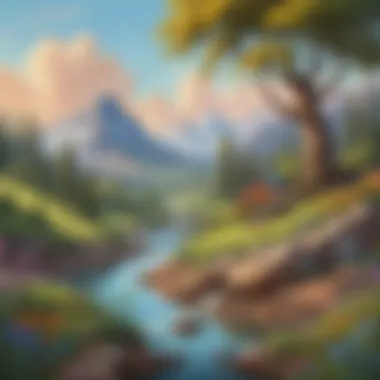
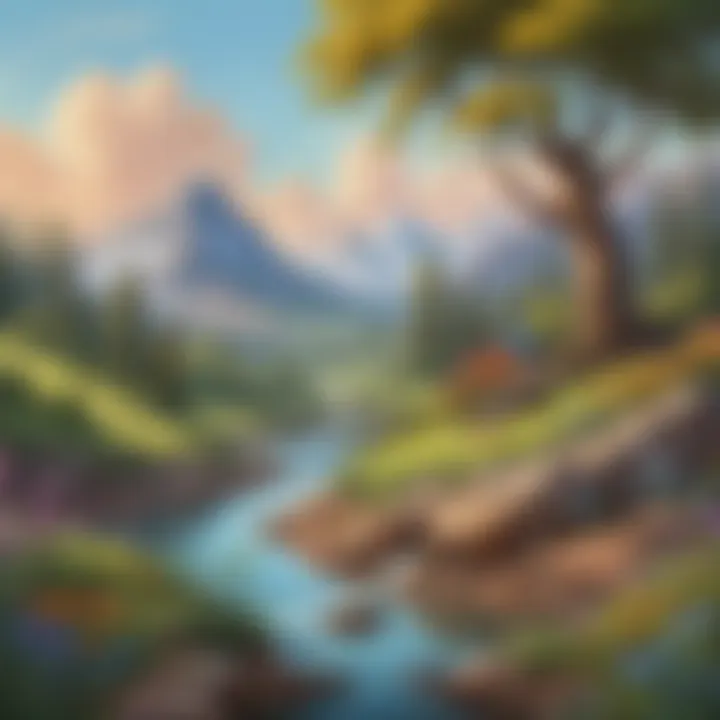
Acrylics
Acrylics are often heralded as a versatile champion among paints. They dry quickly, which allows artists to layer colors without extensive waits. This can be particularly exciting for beginner painters who want to see rapid progress in their artworks. Acrylics also maintain vibrant colors and can be easily mixed with other mediums for creative exploration.
One thing to note, acrylics can become thick or clumpy if not used correctly, so mastering consistency with water is beneficial. They adhere to numerous surfaces—from canvas to wood—leading to a wide range of potential projects.
Tempera Paint
Tempera paint shines for its child-friendly nature. With a water base, it’s safe and non-toxic, making it ideal for young aspiring artists. The opaque quality of tempera allows for vibrant colors that stand out beautifully against paper or cardboard.
While tempera is fantastic for beginners, it is more suited for projects where longevity isn’t critical, as it can fade over time. It also doesn't work well in all conditions, especially under humidity, so it's essential to consider the environment when using it. Overall, tempera paints provide an accessible way to express ideas in a colorful manner without worrying too much about permanence.
Selecting Quality Brushes
The type of brush used in painting can significantly change how colors are applied and how strokes are formed on the canvas. Having a good understanding of different brush types ensures that painters can achieve the results they desire, making it an essential part of the painting process.
Different Brush Types
Brushes come in an array of shapes and sizes, from the fine-tipped detail brushes to larger flat brushes. Each type serves different purposes:
- Round Brushes are great for detail work and can be used for both strokes and fine lines.
- Flat Brushes are excellent for bold strokes and filling in larger areas.
- Fan Brushes can create interesting textures and effects, especially when painting foliage or fur.
Knowing which brush to use for specific effects allows beginners to experiment and learn effectively. Beginners often find that trying out different brush types can lead to unexpected discoveries in their painting style.
Size and Shape Considerations
When it comes to brush size and shape, these elements greatly impact how the paint is applied. Larger brushes can cover more space and create sweeping strokes, ideal for backgrounds. Conversely, tiny brushes work well for intricate details. Here are some benefits of different sizes:
- Large Brushes allow for greater coverage and softer edges.
- Small Brushes provide precision needed for fine details or intricate designs.
Choosing the right size brush not only saves time but can also enhance the painting process for beginners. Understanding the type of work being created can guide decisions in brush selection, ultimately leading to greater satisfaction in the finished piece.
Preparing Your Workspace
Setting up an adequate painting workspace can transform the experience significantly. An organized and inviting area can nurture creativity and make the painting process feel less daunting. Here’s what to consider:
Setting Up Your Painting Area
A dedicated painting area means less distraction and better focus. Ideally, this place should have natural light, a sturdy table, and all necessary supplies within reach. The atmosphere you create will heavily influence the energy and outcomes of your projects.
Having a comfortable chair can help too, since being able to sit and focus on your work for extended periods can enhance creativity.
Protecting Surfaces
Protecting your surfaces while painting is vital. Working on a clean and protected area prevents mess and worries. Consider using old newspapers or plastic sheets to cover your workspace. If you're using paints that might stain or permanently damage your surfaces, adding a layer of protection will not only safeguard your home but also free you to paint with confidence.
"Having a proper workspace is like having a blank canvas—it sets the stage for what’s to come."
In summary, choosing the right supplies, selecting quality brushes, and preparing a conducive space leads to a more enjoyable and productive painting experience. This foundational step is crucial for cultivating the love of painting, especially among beginners.
Basic Painting Techniques
Understanding basic painting techniques is a stepping stone for beginners looking to dive into the beautiful world of art. These techniques not only lay the groundwork for the kind of art one can create but also enhance the learning experience, making it more enjoyable. Techniques such as brush strokes, color layering, and blending are fundamental in establishing how colors interact and express emotions on the canvas. Here, we'll dig into various methods, helping to unlock the creative potential within each young artist.
Brush Strokes and Their Effects
Brush strokes are the very essence of painting. They define the character of a piece and can dictate the mood it conveys. Let’s explore the different types of strokes you can master.
Flat Strokes
Flat strokes are one of the most straightforward techniques in painting. This method involves using the flat side of a brush to cover large areas with color smoothly. A key characteristic of flat strokes is their ability to provide a uniform layer that can create a strong background or a solid color area. For beginners, this method is especially popular due to its simplicity.
Unique in its directness, flat strokes offer a clean, striking look to any painting, allowing for even application of paint. However, it can sometimes lead to a lack of depth and dimension unless layered with other techniques.
Sweeping Strokes
Next, we have sweeping strokes. This technique incorporates a graceful hand motion, resembling a wave or gentle arc. A hallmark of sweeping strokes is their capacity to blend colors while applying them, making it ideal for skies or fluid water scenes.
What makes sweeping strokes appealing is their ability to add a dynamic feel to a painting. However, they require a bit more control than flat strokes, so it might take some practice for beginners to master this technique without going overboard.
Pointillism
Pointillism takes a different angle altogether. This approach revolves around applying small dots of color to form an image. The key characteristic here is the use of basic color theory; the colors blend visually when looked at from a distance, creating a cohesive piece.
Pointillism is not only a beneficial choice for beginners due to its unique method but also encourages patience as artists learn to build their images gradually. The main downside is it can be time-consuming, making it a test of endurance for those eager to see quicker results.
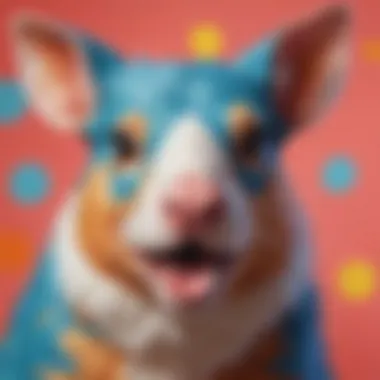

Layering Colors
Layering colors adds richness and complexity to a painting. It involves applying multiple layers of paint to create depth and dimension, enhancing the overall visual experience.
Underpainting
Underpainting is a foundational technique where a basic layer of color is laid down before the final layers. This technique serves as a blueprint for subsequent colors. The primary advantage of underpainting lies in its ability to create a base that can shape the tone and feel of an entire artwork.
By establishing a groundwork, it allows the artist to play with colors above it, enhancing the overall richness of the work. That said, if not executed carefully, the underlayer can become too prominent, overpowering the intended finish.
Building Up Textures
Building up textures introduces a tactile quality to the artwork. This is where artists can experiment with different tools and paints, adding not just color but dimensionality. A key aspect of this technique is its versatility; textures can range from smooth to rough and can express various feelings in a piece.
The exciting part of building textures is that it invites endless exploration. However, it does require a thoughtful approach, as clashing textures can lead to a disjointed final product.
Blending Techniques
Blending techniques are essential in unifying the colors in your artwork. They help create smooth transitions and intriguing depths in a piece.
Wet-on-Wet
The wet-on-wet technique involves applying wet paint onto a wet surface, allowing colors to mix and bleed into each other. A defining characteristic of this method is that it provides a fluid, soft appearance, perfect for skies or backgrounds.
This technique is particularly advantageous for beginners eager to create vibrant, blended backgrounds without overthinking the details. However, it can be tricky to control the amount of color being mixed, resulting in unexpected outcomes.
Dry Brush Technique
The dry brush technique contrasts the wet method. It involves using a brush with little paint on its bristles to create a scratchy, textured effect. This can be useful for achieving finer details and adding a layer of interest to a piece.
One primary benefit of the dry brush technique is its ability to develop texture and detail with minimal paint. The trade-off, however, is that it might not work well on surfaces that need a smooth finish or when working with very wet paints.
Remember, the key to becoming a skilled painter is experimentation. These basic techniques provide the tools you need to express your creativity on the canvas. Enjoy the process, and don’t be afraid to make mistakes; that's where the magic often happens!
Creative Painting Ideas
Creative painting ideas offer an exciting gateway for beginners to express themselves and ignite their imagination. Whether it's through vibrant nature scenes, striking abstracts, or festive themes, every brushstroke creates a pathway to discovery. The beauty of these ideas is not just in the final product but in the journey of creation itself. Exploring various themes helps nurture creativity, allowing artists of all ages to find joy in the process.
Nature-Inspired Themes
Nature provides a limitless well of inspiration for artists. From the sweeping views of landscapes to delicate details in floral designs, nature-themed painting offers beginners a chance to explore colors and forms in a more organic way.
Landscapes
Landscapes are a cornerstone of painting, and their appeal lies in their variety and beauty. This theme allows beginners to explore vast horizons, from serene beaches to towering mountains. One of the key characteristics of landscapes is the ability to capture light and atmosphere. They're also accessible; just step outside, observe your surroundings, and let the earth's beauty guide your brush.
However, capturing the depth and perspective can be challenging, requiring practice to truly master. Still, the reward of painting a landscape that resonates with personal experience or emotion makes it a valuable choice for newcomers.
Floral Designs
Floral designs draw people in with their vibrancy and detail. Flowers can symbolize many things, making them a versatile subject. The unique feature of this theme is the opportunity to explore color mixing and brush techniques, whether it's painting the delicate petals of a rose or a joyful sunflower. The accessibility of flowers, found in gardens and parks, makes this an excellent choice for aspiring painters. The potential pitfall lies in the complexity of details; beginners might find themselves frustrated trying to replicate a flower's nuances precisely. Still, simplifying the shapes can yield beautiful results without all the stress.
Animal Portraits
Animal portraits capture the essence of our furry, feathered, or scaly friends. This aspect lends itself well to creative expression since the personality of each animal can be highlighted through unique brushwork. Its popularity stems from the emotional connection people have with animals. One interesting thing about animal portraits is how they encourage beginners to observe details and colors in a different light. However, the tricky part can be ensuring the likeness, which can take time and practice.
Overall, this path allows for a whimsical approach, making painting simply an extension of love for pets or wildlife.
Abstract and Experimental Ideas
Abstract painting shakes free the constraints of representational art, inviting beginners to make bold choices and express emotions without the need for realism. This freedom often resonates more strongly with young artists.
Color Splash Technique
The Color Splash Technique is all about vibrant expression, making it a joyous activity. This method involves throwing or splattering paint onto a canvas, creating a beautiful chaos. The key characteristic of this technique is the allowance for spontaneity, reflecting the artist’s mood rather than a specific image. It’s a beneficial choice for beginners because it encourages risk-taking and experimentation without the worry of creating a 'perfect' piece. However, cleanup can be a bit of a hassle, so it’s one to consider in the planning phase.
Sponge Painting
Sponge painting introduces a unique texture to artwork by utilizing sponges as brushes. This technique allows artists to create beautiful gradients and patterns easily. What makes it popular is the tactile experience; dipping sponges in paint and applying them brings joy and a playful energy to the canvas. It’s simple, relatively mess-free, and perfect for kids who may be apprehensive about traditional brushwork. Nonetheless, it may lack the level of detail that another technique could offer, but that's part of its charm—sometimes less is more.
Geometric Patterns
Geometric patterns embrace order within creativity, inviting artists to play with shapes and symmetry. This approach can be a beneficial entry point for beginners because it fosters planning and design. One thing to highlight is that the use of tape can help achieve clean lines, perfect for those who might be a little nervous about freehand work. While it presents an organized structure, some might feel limited by the lack of organic forms; however, it also allows for blending colors within recognizable shapes, which can lead to captivating results.
Seasonal and Festive Themes
Painting with the seasons ensures that creative work remains relevant and connected to the world around. Festive themes allow artists to tap into emotions associated with specific times of the year, making their artwork resonate even more.
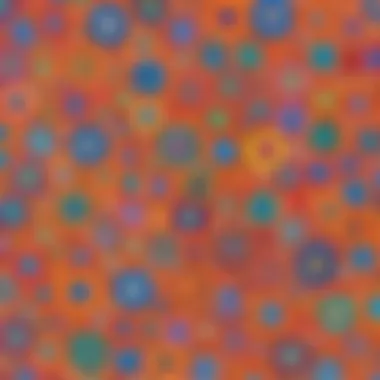
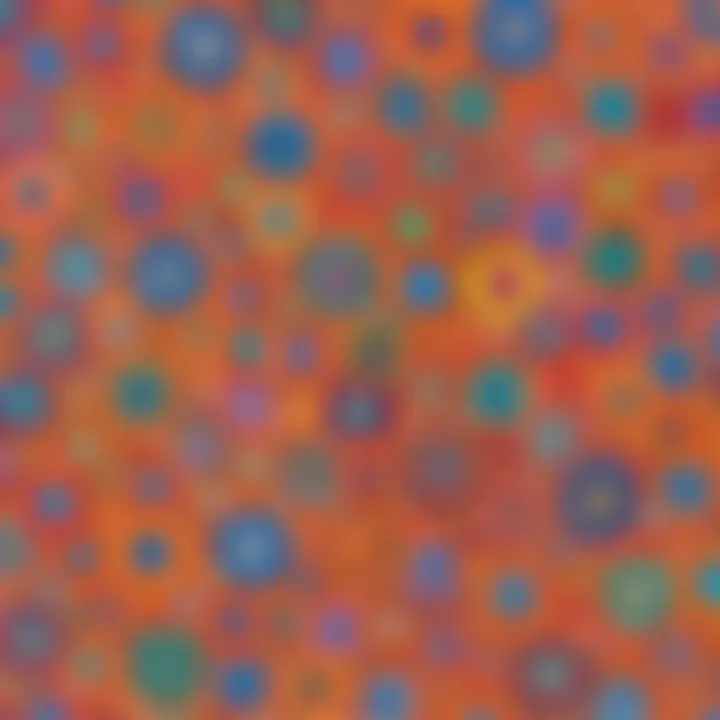
Spring Blossoms
Spring blossoms symbolize renewal and hope, making them a powerful painting subject. The appeal lies in their bright colors and variety of shapes. They allow beginners to practice blending techniques while exploring an explosion of shades. The unique feature here is the way these flowers can instantly uplift a piece, making them an excellent choice for creating cheerful artwork. However, some might find it challenging to capture the delicate quality of petals. But simplifying their shapes can lead to a more stylized representation, making the process less daunting.
Winter Landscapes
Winter landscapes showcase the beauty of the colder months, featuring white blankets of snow and shimmering icicles. What’s beneficial here is the chance to play with light and shadow, creating depth in your work. They offer a unique quality in that they can be serene or chaotic, depending on the artist’s vision. Although the cold palette may seem limiting, it’s a chance to experiment with whites and blues, offering a chance to learn about tonal differences in colors. The downside may be the challenge in depicting textures like snow, which requires some experimentation.
Halloween Imagery
Halloween imagery invites creativity to run wild with spooky themes and vibrant colors. It can be particularly engaging for children, as it involves fun symbols like ghosts and pumpkins. The unique feature of this theme is the ability to mix fun with fright, encouraging expressive and imaginative work. It’s an excellent opportunity for beginners to dive into various styles and color schemes. However, it's important to steer clear of overly complex designs, as they can lead to frustration. Keeping things simple can ensure enjoyment remains the focus of the artwork.
"Creativity takes courage." – Henri Matisse
Incorporating these painting ideas can ignite the artist within every young learner, helping foster a lifetime love for the arts.
Incorporating Different Mediums
In the realm of art, incorporating different mediums into painting opens a treasure chest of possibilities. This approach not only diversifies the creative experience but also allows for greater self-expression and exploration. By blending various materials, young artists can discover new textures, colors, and techniques that enrich their paintings. Using different mediums can be especially engaging for beginners, as it encourages experimentation and invigorates their artistic journey.
Mixing Paint with Other Materials
Using Pastels
Using pastels in conjunction with paint can be a game changer for young painters. Pastels offer a soft and vibrant quality that can complement painted elements beautifully. One key characteristic of using pastels is how easily they can layer upon each other, allowing artists to create dimension and depth. This method benefits beginners as it’s user-friendly; there’s no steep learning curve. Pastels can be quickly blended using fingers or blending tools, which adds to the fun of the process.
One unique feature of pastels is their rich pigmentation. They can produce colors that are exceptionally vivid and expressive. However, they do come with some disadvantages, such as the dust they create, which can be a bit messy and require proper handling. Finding a balance in using pastels alongside paints can truly enhance the artistic experience.
Integrating Collage Elements
Integrating collage elements into paintings is another creative avenue that encourages imagination. This technique involves adding various materials like magazine cutouts, fabric scraps, or natural elements like leaves directly onto the canvas. The beauty of this method lies in its versatility. By mixing painting with collage, budding artists can tell stories through visuals, combining imagery with textures that paint alone can’t achieve.
The key characteristic of integrating collages is how it encourages students to think outside the box. Not only does it develop fine motor skills, but it also prompts critical thinking about composition and design. Additionally, such an approach helps children express their individuality, because each collage piece can reflect personal experiences or interests.
On the flip side, the integration of different elements can sometimes complicate the composition of a painting. It’s essential to guide learners on how to keep their artwork balanced and cohesive. However, the advantages of creative freedom and exploration make this method a popular choice among those eager to express themselves.
Exploring Mixed Media Techniques
Exploring mixed media techniques can be considered an extension of working with different materials. This practice encourages children to combine not just paint with other materials but to mesh a wide array of artistic techniques into one cohesive piece. From using textures to layering colors effectively, mixed media helps cultivate both creativity and critical skill development.
Engaging with mixed media also introduces children to various artistic traditions and cultures, fostering a broader understanding of art as a whole. Key elements include experimenting across disciplines, whether it be painting, drawing, or crafting, and creating artwork that is rich in meaning and perspective. As children continue to experiment with mixed media, they learn the importance of patience, trial and error, and the joy that comes from spontaneity in art.
Sharing and Displaying Artwork
Sharing and displaying artwork is an essential aspect of the creative journey. When beginners, especially young artists, show their artwork to others, it cultivates a sense of pride and accomplishment. This not only boosts self-esteem but also encourages further exploration into the world of painting. It’s a way to validate their efforts and foster a connection between the artist and the audience. Displaying artwork can turn a simple creation into a conversation starter, igniting discussions that can inspire new ideas and projects.
Creating a Home Gallery
Setting up a home gallery is a wonderful activity that allows young artists to showcase their work. Transforming a wall into a mini-gallery can be both fun and fulfilling. Begin with selecting a space that is well-lit and can be accessed frequently by family and friends.
- Choose the Right Location: A hallway, living room, or even a dedicated wall in a bedroom can serve as the perfect backdrop.
- Framing Artwork: Simple frames can enhance the presentation. Kids can even decorate their frames to personalize them.
- Rotating Exhibitions: Have a rotating display where new artworks replace older ones, giving each piece its moment in the spotlight.
- Labels and Dates: Encourage the young artist to label their art with titles and dates to track their progress over time.
Creating a home gallery not only fosters a sense of accomplishment but also lets children appreciate their own development as they see their skills improve over time. It makes their art feel valued and invites feedback from friends and family, which can be incredibly rewarding.
Participating in Community Exhibits
Community exhibits can be a thrilling experience for both novice artists and their families. These events often open doors for young painters to connect with others who share their passion for creating.
- Finding Local Exhibits: Schools, libraries, and community centers frequently host art shows. Look for announcements about upcoming events in local newspapers or online community boards.
- Preparing Work for Display: It’s important to present the artwork well. Discuss with children how to mat or frame their pieces neatly.
- Artist Statements: Encouraging young artists to write a short statement about their artwork can help them articulate their thoughts and feelings.
- Engaging With the Audience: At the exhibit, kids can practice presenting their work, explaining their process, or answering questions. This can help build public speaking skills and confidence.
Participating in community exhibits not only provides a platform for sharing artwork but also serves as a learning experience. By interacting with visitors, children can gain different perspectives and, perhaps, even discover new avenues for their future artistic endeavors.
"Art is not what you see, but what you make others see." - Edgar Degas
In the end, whether it’s a cozy corner in the living room or an exciting community venue, sharing and displaying artwork is a key element in nurturing young artists, helping them appreciate their journey and discoveries in the world of painting.
Closure: Embracing the Journey of Painting
Painting is not just a hobby; it’s a journey filled with creativity, exploration, and personal growth. For beginners, especially elementary school children, embarking on this artistic adventure can be a gateway to discovering one’s self-expression. In this article, we’ve traversed various avenues of painting, providing insights into techniques, themes, and materials that fuel artistic inspiration.
One key reason this journey matters is the development of fine motor skills. As young painters wield their brushes, they enhance their hand-eye coordination and dexterity. Each stroke teaches them precision and control, which can carry over to other activities, such as writing or crafting.
Additionally, the act of painting encourages emotional expression. Children often find it difficult to articulate their feelings verbally. Through colors and strokes, they can convey happiness, sadness, or excitement without needing to put their emotions into words. When a child paints, they engage in a form of communication. The colors they choose can reflect their mood or thoughts, creating a unique dialogue between the artwork and the viewer.
Moreover, embracing the painting journey fosters patience and perseverance in children. Art doesn’t always go as planned, and learning to accept mistakes is a critical skill. When a painting doesn’t turn out quite right, the child is presented with an opportunity to adapt and adjust. This process teaches resilience, showing that there’s beauty in imperfection.
"Creativity takes courage." – Henri Matisse
To fully harness the benefits of painting, it’s vital for parents and caregivers to support and encourage these artistic endeavors. Setting up a dedicated space for painting at home can create a safe haven for exploration. Encouraging children to try out different mediums and themes, such as nature-inspired designs or abstract ideas, can further ignite their curiosity and creativity.
Consider organizing community exhibits where young artists can showcase their work. This not only provides a platform for them to share their creations but also instills a sense of achievement and belonging.







